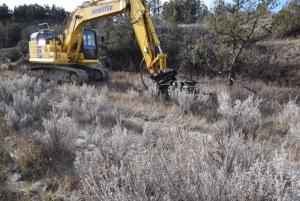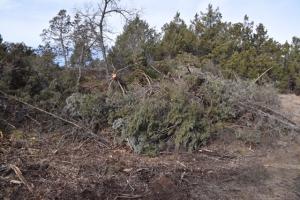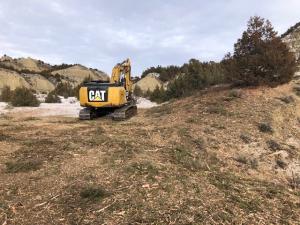NRCS Helps Slow "Green Wave" of Encroaching Junipers on Grassland
Kim Shade and Alan Richard are trying to stop the spread of Rocky Mountain junipers on their ranches near Medora in southwest North Dakota.

“Junipers have become my worst noxious weed,” says Shade. He bought a track hoe mounted tree shear last year to remove junipers that are encroaching on grasslands.
“Junipers have become a real problem,” agrees Richard. He hired a track hoe mounted tree masticator to chop and grind up junipers that have spread into grasslands.
Both men are working with the Natural Resources Conservation Service in North Dakota to remove junipers. Additional juniper removal is occurring on adjacent and neighboring National Grasslands administered by the Forest Service.
Green wave
Rocky Mountain junipers are native species, but historically the evergreen trees have mostly only grown on north facing draws and near butte summits in the Badlands. Before European-American settlement, frequent natural wildfires kept the trees in check. But over the past 100 years -- as the open range was fenced for grazing and farming, and fires were controlled – junipers have spread into grasslands.

A juniper invasion happens slowly. The early stages often escape notice. The seeds are spread mostly by birds. At first, the encroaching trees are just spindly seedlings or small shrubs here and there that don’t seem to affect how much grass is produced. But gradually there are more and more trees and they get bigger and bigger.
“It is like a slow green wave coming at you,” says Mike Gerbig, NRCS Badlands Conservation Delivery Unit supervisor, Dickinson, N.D.
Others have likened it to a “green glacier.”
“One day, you look at that land and realize, ‘wow,’ something has really changed,” Shade says.

Big water users
It is important to stay ahead of juniper encroachment because the trees can completely change grasslands, says Mark Hayek, NRCS state rangeland specialist in North Dakota. “They are master manipulators of the environment.”
An 8 ½-inch diameter juniper tree can consume 30-35 gallons of water a day. The Badlands get only about 14 inches of precipitation a year, and large junipers can consume nearly all the precipitation that falls on them in a year.
“They use so much water that dense stands can dry up springs and creeks,” he says.
When the juniper stands become thick enough that the branches from adjacent trees touch each other, they shade out all the grasses and shrubs beneath them. There’s nothing for wildlife and livestock to eat. Deer, turkey, elk and cattle avoid dense stands. Many grassland birds – including sharp-tailed grouse, greater sage grouse and others – lose their habitat.

Junipers also set the soil up for severe erosion because the soil beneath the trees isn’t covered or anchored.
The wildfire risk increases with the spread of junipers, says Misty Hayes, U.S. Forest Service district ranger, Medora, N.D. The trees contain an oil and burn hotter than grass. Because they are taller than grass, junipers can throw hot embers farther than grass, making it harder to control wildfires with fire breaks.
“Wildfires in junipers can be several times more dangerous than grassland wildfires,” Hayes says.
Joint chiefs project
In 2019, the NRCS and the U.S. Forest Service teamed up and created the North Dakota Badlands Restoration Project to manage native Rocky Mountain juniper stands using mechanical methods. Cutting off or grinding up junipers is an effective way to remove junipers because junipers don’t sucker or re-sprout from roots or stumps. USDA budgeted more than $3 million over three years for NRCS and the U.S. Forest Service to remove or help private landowners remove junipers from thousands of acres of private and public land in Billings, Golden Valley, McKenzie and Slope counties within and adjacent to the Little Missouri National Grassland.
The project was initially funded for three years. But junipers will likely continue to be the focus of conservation efforts for many years to come. It’s estimated that there are 150,000 acres of juniper draws in the North Dakota Badlands.
For more information on financial assistance for and technical advice about removing junipers, contact your local NRCS field office.
Media contact:
Lon Tonneson
for the Natural Resources Conservation Service - North Dakota
lon.tonneson@gmail.com
701-361-1105

